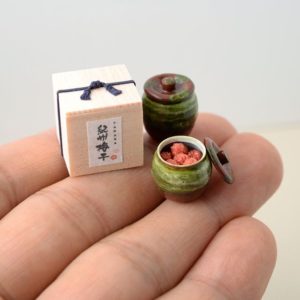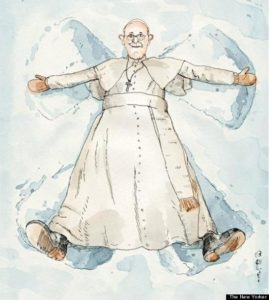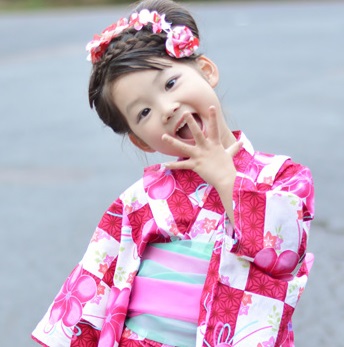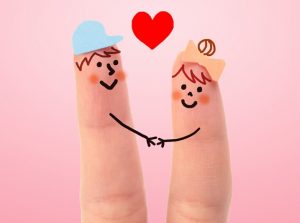Learn Kanji | 1st Grade
小 (ちいさい)
 |
Definition: small |
| Kun-yomi: ちい・さい、ちい・さ(な) | |
| On-yomi: ショウ |
Overview

The Kanji for “small” is almost as easy to visualize as its opposite (大), if you think of the strokes as representing three tiny things.
Similar to 「大きな」, 「小さな」 is another one of those funny adjectives that you can’t conjugate and only use as is. Stick with the i-adjective 「小さい」 for conjugations eg 「小さくない」 NOT 「小さじゃない」.
Examples
Example 1
-
なんでもちいさくすればかわいくみえるよね。Anything looks cute if (you) make (it) small, doesn’t it?
Example 2
A: しょうがくせいのときになにになりたいとおもってた?
A: What were (you) thinking (you) want to become when (you) were elementary school student?
B: う~ん、よくおぼえてないね。そっちは?
B: Hmm… (I) don’t remember well. How about (your) side?
A: パパのおよめさんとうちゅう ひこうし。こどもってバカだよね。
A: Papa’s bride and astronaut. Kid(s) are stupid, huh?
B: そこはほほえましいっていおうよ!
B: Let’s call that heart warming!Next Suggestions
大(おおきい)
 |
Definition: big |
| Kun-yomi: おお・きい、おお・き(な) | |
| On-yomi: ダイ、タイ |
Overview

As you can see by this image of the Pope, 「大」 is yet another one of those simple Kanji that is easy to memorize AND visualize.
The only tricky part is figuring out which reading to use in Kanji compounds. There is no rhythm nor reason for why 「大学」 is read as 「だい」 vs 「大使館」 as 「たい」 except perhaps those readings roll easier on the tongue. If you’re new to Kanji, you’ll see this is often the case for common characters with multiple readings.
As for 「大きな」, this is one of those funny adjectives that you can’t conjugate and only use as is. Stick with the i-adjective 「大きい」 for conjugations eg 「大きくない」 NOT 「大きじゃない」.
Examples
Example 1
-
たくさんたべないとおおきくなれないよ!If (you) don’t eat a lot, (you) can’t become big, you know!
Example 2
A: おおきさより、やっぱりかたちがだいじだよね。
A: (The) shape is more important than size, isn’t it?
B: なんのはなしをしているの?
B: What are (you) talking about?
A: えっ?いや、ひこうきにもちこめるてにもつのはなしですが・・・。
A: Huh? Um, (it’s) about hand luggage that (you) can take into (the) airplane…
B: それ、ぜったい うそだよね。
B: That’s definitely a lie, isn’t it?Example 3
A: ねえ、だいじなことをわすれてない?
A: Hey, aren’t (you) forgetting something important?
B: ああ、あれ?なんとかごまかせそうだからだいじょうぶだよ。
B: Oh, that? Looks like (I) can somehow fake it so it’s ok.
A: そう?まあ、おおごとにならなければいいけど・・・。
A: Is that so? Well, as long as it doesn’t become a big incident.
B: いま、ちがうたんごをおなじかんじで言わなかった?
B: Did you say a different word by the same Kanji right now?
A: なにをいっているの?かんじをかいわでいえるわけないでしょう?それとも、なに?わたしがいっていることがぐげんかして、めにみえてるわけ?まんがじゃあるまいし。
A: What are (you) saying? There’s no way I can say a Kanji in conversation, right? Or what? Are you concluding that what I’m saying materializes and is visible to the eye? It’s not like this is a Manga.
B: だから、なんでそんなまぎらわしいかんじや、むずかしいたんごとぶんぽうをつかっているんだよ?!かんじをべんきょうしはじめたばかりのひとがパニックになってにげちゃうだろうが!
B: So why are you using such confusing Kanji and difficult words and grammar? People that just started studying Kanji will fall into a panic and run away!A: はあ?
A: Huh?
Next Suggestions
口(くち)

|
Definition: mouth |
| Kun-yomi: くち | |
| On-yomi: コウ |
Overview
You might be asking why is mouth a square, not a circle? Honestly, I have no frickin’ clue. Oddly enough, circle is a shape that is not used in Kanji (○ is a symbol, not Kanji). Even the Kanji for “circle” (丸) is not round in the slightest! Maybe something to do with how brush strokes work, I dunno.Anyway, it is what it is, a square to symbolize a big, open mouth. Take EXTRA care to learn the stroke order because this is also a very important radical that will be used in quite a few other characters.
Also, this is visually identical to the Katakana: ロ but totally different OBVIOUSLY. (Rolls eyes)
Examples
Example 1
-
ひとのくちはまるいのに、くちのかんじは、なぜかしかくになっている。Despite people’s mouths being round, (the) Kanji for “mouth” is square for some reason.
Example 2

A: ねえ、にほんじん じょせいは、なんでわらう ときにくちもとをてでかくすの?
A: Hey, why do Japanese women hide (their) mouth with (their) hand when (they) laugh?
B: たぶん、はがやばいことになっているからでしょう?
B: Probably because (their) teeth are in serious trouble.
A: しつれいね!そんなのとかんけいないよ!きっとぶんかのちがいよ。
A: That’s rude! That has nothing to do with it! I’m sure (it’s a) cultural difference
B: もうわかってんなら、おれにきくなよ。
B: If (you) know already then don’t ask me.Example 3
Even though Alien registration card is no longer a thing in Japan, the individual words are still very worthwhile to learn.
A: わたしがにほんにいったときは、がいこくじん とうろく しょうめいしょがないとぎんこうのこうざがひらけなかったな。
A: When I went to Japan, (I) couldn’t open (a) bank account without alien registration card.
B: へえ、そうなんですか?
B: Huh, is that so?
A: でも、それがとどくまでさんかげつかかって、きゅうりょう ふりこみができなくて、ほんとうにたいへんだった!いまはどうなんだろう?
A: But that took months to arrive and couldn’t get payroll direct deposit and (it) was really rough! How is it now (I wonder)?
B: へえ、そうなんですか?
B: Huh, is that so?
A: はなし、きいてないし・・・。
A: (You’re) not listening to my story…Next Suggestions
四(よん)

|
Definition: four |
| Kun-yomi: よん、よっ・つ | |
| On-yomi: シ |
Overview
Well, the easy ride is over but it was great while it lasted, wasn’t it? 「一二三」, let’s see, that’s 3 out of about 2,000+ characters so… progress?
There’s several explanations on how 「四」 came to be and most of them involve the fact that it comes from a combination of: 口+八. However, the inside part more clearly resembles the 「儿」 leg radical (note: this radical is not a kanji by itself). If these Kanji are new to you and you prefer to learn in radical order, you may want to skip to the next suggestions.
One suggested memonic was an image of an open mouth to signify that your breath is impossible to count (one, two, three, many). This one must go back to the caveman days where four was considered a bigly number? In any case, this Kanji is still common and simple enough you could probably memorize it by brute repetition anyway. Hmph!
Examples
Example 1
-
よんのかんじはどうしてこうなったのよ!Why did the Kanji for 四 become this way?!
Example 2

A: よつばのクローバーをみつけたらしあわせになれるんっだって。
A: (They) say if (you) find a four-leaf clover, (you) can become happy.
B: じゃ、わたしはしあわせじゃないっていっているの?
B: Then, are (you) saying I’m not happy?
A: いや、べつに・・・
A: No, not particularly…
B: わたしはいまでもじゅうぶん しあわせだよ!
B: I’m plenty happy even now, you know!
A: あのう、だいじょうぶ?
A: Um, (are you) ok?Example 3
A: よつんばいになって、なにしているの?
A: What are (you) doing crawling on all fours?
B: コンタクトをおとしちゃったんだ。
B: (It’s that) I dropped (my) contact lens.
A: たいへんだね。じゃ、またね!
A: (That’s) rough. Well, see you later!
B: ちょっとてつだってよ!
B: Hey, help (me) a little!Next Suggestions
人(ひと)

|
Definition: person |
| Kun-yomi: ひと | |
| On-yomi: ニン、ジン |
Overview
This one is pretty easy and given my (lack) of drawing ability, this is what my pathetic attempts to draw a person typically look like. My drawing ability is so bad, xkcd practically looks like Monet in comparison.
However, don’t be lulled into a false sense of security as the tricky part is remembering whether to read it as 「じん」 eg 「日本人、未亡人」 or 「にん」 eg 「職人」. Not to mention some of those tricky words with readings completely divorced from the actual characters: 「大人、一人、二人、仲人、若人、玄人」 etc. Don’t worry about them if you’re still relatively new to Kanji for now.
Examples
Example 1
-
ひとはおおきくなると、おとなになる。たぶん。When people become big, (they) become adults. Maybe.
Example 2

A: PDAってひととしてありえないとおもわない?
A: Don’t (you) think PDA is inconceivable as a person?
B: なにそれ?
B: What is that?
A: そんなのもしらないの?ひとまえでイチャつくことだよ。
A: (You) don’t even know that kind of thing? (It’s) getting all frisky in front of people.
B: へ〜、なんのりゃく?
B: Huh, what’s (it) stand for?A: ええと、ええと、「パブリック・デート・ああ、はしたない」だったっけ?
A: Umm, umm, was it “Public Date Ah, so shameful”?
B: よくわかんないけど、それ、ぜったい ちがう!
B: (I) don’t know all that well but (that’s) definitely not it!Example 3
A: にほんじんは、さ・・・
A: Hey, about Japanese people…
B: ちょっとまって。まさか、じんしゅ さべつのはつげんをしようとしてるんじゃないでしょうね?
B: Wait a sec. (You’re) not by any means about to say something racist, right?
A: しんがいだ!おれは、どんなひとだおもっているの?
A: How could you think that! What kind of person do (you) think I am?
B: う~ん、じゃ、いちおう きいておこう。それで?
B: Ummm, then, let’s hear (it) for now. So then?
A: にほんじんは、どうしてにほんじんなんだろう?
A: (I) wonder why are Japanese people Japanese?
B: きいてそんした。
B: (I) listened/asked and lost out.Next Suggestions
三(さん)

|
Definition: three |
| Kun-yomi: みっ・つ | |
| On-yomi: サン |
Overview
This Kanji thing is a cinch! At this rate, we’ll learn everything in no time, right guys?
Examples
Example 1
-
さんのかんじもぜんぜん むずかしくない!(The) Kanji for “three” is also not hard at all!
Example 2
In this next example, 「姦しい」 is not very commonly used (better to memorize 「やかましい」 or 「騒がしい」). However, the proverb is interesting in terms of the actual Kanji, I just had to include it here.
A: おんな さんにん よればかしましい。
A: If 3 women gather, (it) gets noisy.
B: しにたいのかしら?
B: Do (you) want to die?
A: ことわざをべんきょうしてるだけだよ!
A: (I’m) just studying proverbs!Example 3
A: さんかく かんけいって、なんかいいですよね。
A: Something about love-triangle, isn’t (it) nice?
B: うん、たぶん、いま そうぞうしてるのは、ぜんぜん ちがうから。
B: Yeah, (what you’re) probably imagining right now is totally wrong so…
A: かわいいおんなのこ ふたりにかこまれてですね。
A: (You’re) surrounded by two cute girls and then, right?
A: やっぱり。まっ、ゆめがあっていいんじゃない?
B: I knew it. Well, (I guess it’s) good to have dreams.Next Suggestions
二(に)

|
Definition: two |
| Kun-yomi: ふた・つ | |
| On-yomi: ニ |
Overview
Just two horizontal lines to mean “two”. Awesome, Kanji is so logical. You got this!This Kanji also happens to look exactly like the Katakana 「ニ」, which is also how it’s read! I don’t know if that’s helpful or confusing.
If we’re talking about 「に」, how could I forget the Knights who say Ni! I assume not the same word but at least it sounds the same!
Examples
Example 1
-
にのかんじもかんたん!(The) Kanji for “two” is also easy!
Example 2
A: いっせき にちょうだ。
A: One stone, two birds. (Kill two birds with one stone.)
B: それ、どうぶつ ぎゃくたいだよ。
B: That’s animal abuse.A: ことわざだよ!
A: (It’s) a proverb!
Example 3
A: ふつか よいであたまがガンガンするよ。
A: (My) head is pounding from (a) hangover.
B: にじかいにいくからそうなるのよ。
B: (It) ends up that way because (you) went to the after-party.
B: にじかい、あったっけ?
B: Was there (an) after-party?A: だめだこりゃ
A: This is no good.
In case you’re not familiar with the expression 「だめだこりゃ」, check out the video below.
Sorry, has nothing to do with Kanji!
Next Suggestions
一(いち)

|
Definition: one |
| Kun-yomi: ひと・つ | |
| On-yomi: イチ |
Overview
What could be easier than this single-stroke Kanji for one! Maybe Kanji isn’t so hard after all?Examples
Example 1
-
いちは、いちばんです!One is number 1 (the best)!
Example 2
A: わたしは、いっさいです。
A: (I’m) one year old.
B: じゃ、なんではなせるの?
B: Then, how come (you) can talk?Example 3

A: このかわいいにんぎょうをひとつください。
A: Please give (me) one (of) this cute doll.
B: あのぶきみなチャッキーのようなおにんぎょうですね。かしこまりました。
B: That disturbing doll that looks like Chucky then? Certainly.A: …
A: …
Example 4
A: ひとりでたびするの?
A: (You’re) traveling alone?
B: そう、じぶん さがしのたび。
B: That’s right, trip to find myself.
A: かのじょ、いないんだ。
A: You don’t have (a) girlfriend, (I see).
B: ちがうよ!
B: That’s not it!
0 Response to "Learn Kanji | 1st Grade"
Post a Comment